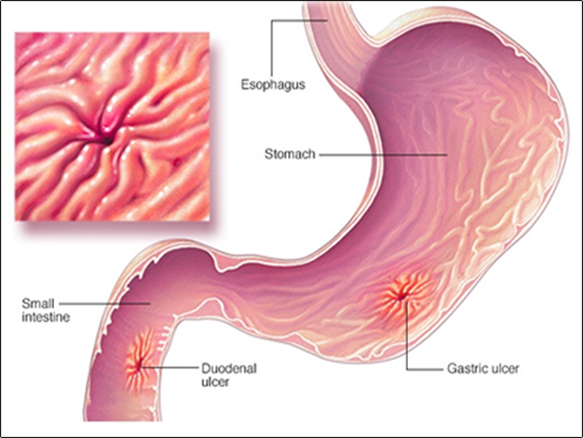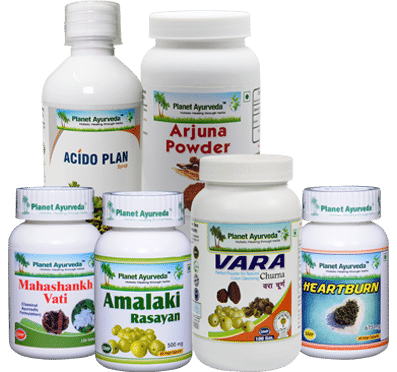Natural Ayurvedic Remedies for Duodenal Ulcer Relief
Abstract
Duodenal ulcers are lesions that occur in the lining of the duodenum, the first section of the small intestine. These ulcers develop when there is a disruption between the stomach’s digestive acids and the protective barriers of the stomach and duodenum. The primary causes of duodenal ulcers are Helicobacter pylori infections and the extended use of nonsteroidal anti-inflammatory drugs (NSAIDs). Symptoms typically include abdominal pain, bloating, and indigestion, often worsening when the stomach is empty. Timely diagnosis and treatment are vital to prevent serious complications such as bleeding, perforation, and gastric blockages. In this article we will discuss this in detail along with its ayurvedic overview.
Introduction
Duodenal ulcers are a type of peptic ulcer that forms in the lining of the duodenum, the initial section of the small intestine. These ulcers arise when there is an imbalance between the digestive acids produced in the stomach and the protective lining of the digestive tract. The main causes of duodenal ulcers are Helicobacter pylori infection and the prolonged use of nonsteroidal anti-inflammatory drugs (NSAIDs).

Causes
Causes of duodenal ulcers includes
- Helicobacter pylori Infection: A major cause of duodenal ulcers is infection with the Helicobacter pylori bacteria, which weakens the stomach and duodenum’s protective lining, making them more vulnerable to acid damage.
- Long-Term NSAID Use: The frequent or extended use of nonsteroidal anti-inflammatory drugs (NSAIDs) like ibuprofen and aspirin can irritate and damage the stomach and duodenal lining, leading to ulcers.
- Excessive Alcohol Intake: Drinking large amounts of alcohol can irritate and damage the gastrointestinal lining, increasing the likelihood of ulcer formation.
- Smoking: Smoking significantly raises the risk of duodenal ulcers by promoting excess stomach acid production and weakening the protective mechanisms in the stomach and duodenum.
- Stress: While stress alone doesn’t directly cause ulcers, it can aggravate existing ulcers or interfere with healing, as it may increase stomach acid production.
- Genetic Factors: A family history of ulcers can make someone more likely to develop duodenal ulcers, indicating a genetic predisposition to the condition.
- Dietary Factors: Although not a direct cause, foods like spicy foods, caffeine, and acidic foods can irritate the stomach lining, worsening ulcer symptoms.
- Aging: Older individuals are more at risk for duodenal ulcers due to factors such as reduced mucus production, other health conditions, and greater reliance on medications like NSAIDs.
- Pre-existing Health Conditions: Certain diseases, such as Zollinger-Ellison syndrome, which leads to excessive acid production, can increase the risk of developing duodenal ulcers.
Symptoms
Symptoms of Duodenal ulcers includes
- Burning or gnawing stomach pain, often occurring when the stomach is empty or at night abdominal bloating
- Indigestion (dyspepsia)
- Nausea or vomiting
- Loss of appetite
- Weight loss
- Heartburn
- Frequent burping or belching
- Dark or tarry stools, which may indicate bleeding
- Fatigue or weakness (due to blood loss or anemia)
Diagnosis
Diagnosis of Duodenal ulcers includes
1. Physical Examination and Patient History
The doctor will ask about symptoms, lifestyle habits, medication use, and family history of ulcers. They will also conduct a physical exam, focusing on the abdomen for tenderness or discomfort.
2. Endoscopy
A procedure where a flexible tube with a camera (endoscope) is inserted through the mouth to directly view the stomach and duodenum. This is the most accurate way to identify ulcers and check for complications like bleeding.
3. Testing for Helicobacter pylori
- Breath Test: The patient drinks a special liquid, and if H. pylori is present, it produces a detectable gas as it breaks down the substance.
- Blood Test: Detects antibodies related to H. pylori infection.
- Stool Test: A stool sample is analyzed to detect the presence of H. pylori.
4. X-rays (Upper GI Series)
An X-ray procedure where the patient swallows a contrast material (barium), allowing clear images of the stomach and duodenum. This method is becoming less common due to the more detailed information provided by endoscopy.
5. Blood Tests
Blood tests may be used to check for infection, anemia (due to potential blood loss), or other underlying health concerns.
6. Biopsy
A small tissue sample from the ulcer may be taken during an endoscopy for examination, particularly if the ulcer may be cancerous or to check for H. pylori infection.
7. Stool Blood Test
A test to detect hidden blood in the stool, which could indicate bleeding from the ulcer.
Treatment
Treatment for a duodenal ulcer depends on its underlying cause.
Possible Treatment options include
- Antibiotics: They help eliminate H. pylori bacteria responsible for the ulcer.
- Proton Pump Inhibitors (PPIs): These Drugs reduce stomach acid production, preventing acid buildup and promoting ulcer healing.
- H2 Blockers: work by inhibiting stomach acid production, helping to prevent ulcers.
- Antacids: Over-the-counter remedies neutralize stomach acid, offering relief and reducing ulcer risk.
- Sucralfate (Carafate): This drug creates a protective barrier over the ulcer, shielding the stomach and duodenum from acid damage.
Ayurvedic Overview
In Ayurveda, Duodenal ulcers are correlated with Parinama Shoola. Shool (Colic or abdominal pain) that occurs during the digestion of food is called Parinama Shoola. When exposed to factors that aggravate Vata, it becomes disturbed beyond normal levels. This imbalanced Vata then combines with morbid Pitta and Kapha, eventually becoming obstructed by these two doshas. This combination of disturbed Vata, blocked by Pitta and Kapha, leads to intense pain, known as Parinaam Shoola. The Kapha in the stomach gets displaced from its usual position, and this disturbed Pitta merges with Pitta itself. As the imbalanced Vata continues to displace both Pitta and Kapha, it causes severe pain, particularly during digestion. This condition is referred to as Parinaam Shoola.
Symptoms
Symptom of Parinam Shoola includes
- Pain during the digestion of food
- Pain in abdomen and navel region
- Pain in the region of urinary bladder
- Pain in the sternal region
- Pain in the sacral region
- Abdominal distension
- Gurgling sound
- Constipation and urinary obstruction
- Burning sensation
- Excessive sweating
- Nausea
- Vomiting
Relieving factors
- After intake of food
- After vomiting
- After complete digestion of food
- After taking Medicated ghee and oils and hot comforts (Like steaming and hot foods etc.)
Treatment
Line of treatment for Parinam Shoola
- Langhana (Fasting)
- Vamana (Therapeutic emesis)
- Virechana (Therapeutic purgation)
- Vasti (medicated enemas)
Home Remedies for Duodenal Ulcers
- Honey: Honey has antibacterial properties and may help soothe the ulcer and promote healing. A tablespoon of raw honey can be consumed daily.
- Aloe Vera: Aloe vera juice has anti-inflammatory and healing properties that can help reduce irritation in the digestive tract. Drink 2–3 tablespoons of aloe vera juice before meals.
- Ginger: Ginger helps reduce stomach acid and promotes digestion. Drinking ginger tea or adding fresh ginger to warm water can provide relief from ulcer pain.
- Cabbage Juice: Cabbage juice is known to help heal ulcers due to its high levels of glutamine. Drinking 1/2 cup of fresh cabbage juice before meals can aid healing.
- Bananas: Bananas are gentle on the stomach and help coat the ulcer, providing relief from pain. They can also promote mucus production, which protects the stomach lining.
- Licorice Root: Licorice has been used to treat ulcers.
- Slippery Elm: This herb is soothing for the stomach lining. Mix slippery elm powder with warm water and drink it to reduce irritation and inflammation.
Yoga for Duodenal Ulcers
- Pawanmuktasana (Wind-Relieving Pose): This pose can help alleviate digestive issues like bloating and discomfort, improving overall digestion.
- Bhujangasana (Cobra Pose): Cobra pose strengthens the abdominal muscles, stimulates the digestive organs, and helps improve blood circulation to the stomach and duodenum.
- Setu Bandhasana (Bridge Pose): This asana stimulates the abdominal organs, reduces tension, and promotes overall digestive health.
- Viparita Karani (Legs Up the Wall Pose): This pose is restorative, calming the nervous system and promoting better digestion by improving circulation to the digestive organs.
- Pranayama (Breathing Exercises): Focus on deep, slow breathing techniques such as Anulom Vilom (Alternate Nostril Breathing) to reduce stress, which can be a contributing factor to ulcers.
- Paschimottanasana (Seated Forward Bend): This pose can relieve tension and pressure from the abdominal area and promote relaxation.
Acupressure Tips for Duodenal Ulcers
- ST36 (Zusanli): Located below the knee, this point helps strengthen the digestive system, improve overall stomach health, and aid in ulcer healing.
- CV12 (Zhongwan): Located in the center of the abdomen, pressing this point can help alleviate digestive discomfort and promote healing of ulcers.
- LI4 (Hegu): This point, located between the thumb and index finger, can help relieve pain, reduce stress, and improve overall digestion.
- PC6 (Neiguan): Located on the inner forearm, pressing this point can alleviate nausea and improve digestion.
- SP6 (Sanyinjiao): Found on the inside of the lower leg, this point is useful for improving digestion and balancing stomach function.
- GB20 (Fengchi): Located at the base of the skull, massaging this point can help reduce stress, improve circulation, and support digestive health.
Additional Tips
- Avoid irritating foods: Avoid spicy, acidic, or fried foods, which can worsen ulcer symptoms.
- Eat small, frequent meals: Eating smaller portions throughout the day can help reduce stress on the digestive system and minimize pain.
- Stay hydrated: Drink plenty of water, but avoid caffeinated, carbonated, or alcoholic beverages.
- Manage stress: Practice relaxation techniques such as meditation, mindfulness, or gentle yoga to reduce the impact of stress on ulcer development.
Herbal Remedies for Duodenal Ulcers by Planet Ayurveda
Planet Ayurveda is a reputable GMP certified brand that offers a wide range of herbal products based on Ayurvedic principles, aimed at promoting overall health and addressing specific concerns with natural, plant-based formulations.All their formulations are prepared under the supervision of MD (Ayurveda) scholars. They provide a variety of Ayurvedic formulations to support the management of duodenal ulcers including, Mahashankh Vati, Acidoplan Syrup, Vara churna, Amalaki rasayan, and HeartBurn Capsule. Planet Ayurveda emphasizes a holistic approach, combining high-quality herbal formulations with dietary and lifestyle recommendations for long-term digestive wellness, making their products effective and safe for ulcer management.
1. Mahashankh vati
This tablet is a pure extract of Shunthi (Zingiber Officinale), Pippali (Piper Longum), Shankha Bhasma (Turbinella Pyrum), Tamarind bark (Tamarindus Indica) , Rock salt (Halite), Black salt (Black salt) etc. It is known for its ability to neutralize excess stomach acid. Since duodenal ulcers are aggravated by high acidity, this formulation can help reduce the acid levels in the stomach, thus preventing further irritation to the ulcerated areas of the duodenum.
Dosage : 1 tablet three times a day with lukewarm water before a meal
2. Heartburn capsule
This capsule is blend of Praval Pishti (Coral Calcium), Akik Pishti (Agate Calcium), Jahar Mohra Pishti (Calcium Compound), Kamdudha Ras, Mukta Pishti (Pearl Calcium), Giloy Satva (Tinospora Cordifolia ). It aids in neutralizing excess acidity and also works to restore balance to an overactive pitta.
Dosage : 1 capsule two times a day with normal water after a meal.
3. Amalaki Rasayan
This capsule is a standardised pure extract of Amalaki (Emblica Officinalis). Amla helps balance all three doshas, but it primarily has an effect on pacifying the Pitta dosha.it helps in improving digestion and boosting appetite. It can help regulate the digestive process and prevent conditions like indigestion or bloating, which can exacerbate ulcer symptoms.
Dosage: 1 capsule two times a day with plain water after a meal
4. Acidoplan Syrup
This Syrup is a blend of patola (Trichosanthes Dioica), Sajjikshar (Soda-bi-carb), Ghrit Kumari (Aloe Barbadensis), Sauf (Foeniculum Vulgare), Kokum (Garcinia Indica), Pittapapada (Fumaria Indica), Shatavari (Asparagus Racemosus) etc. All these herbs help to neutralize excess stomach acid, which is a primary factor in the formation and aggravation of duodenal ulcers. Acidoplan Syrup is formulated to balance the Pitta dosha by providing cooling and calming effects, which can help alleviate the symptoms of an ulcer.
Dosage : 2 tsp twice a day
5. Vara Churna
This herbal powder is a pure blend of Haritaki (Terminalia Chebula), Amalaki (Emblica Officinalis), Bhibhitaki (Terminalia Bellerica). Vara Churna typically contains herbs that help balance Pitta, reducing acidity and inflammation that contribute to ulcer formation.
Dosage : ½ tsp of powder mix it in warm water and consume it in the evening time.
6. Arjuna Powder
This herbal powder is a pure blend of Arjuna (Terminalia Arjuna). Arjuna (Terminalia Arjuna) has Anti- inflammatory and Antioxidant properties. It is known to have cooling and soothing properties that help in balancing the excessive Pitta, thus promoting better digestive health and it helps to heal ulcers by enhancing tissue regeneration and help in healing the damaged mucosal lining of the gastrointestinal tract.
Dosage : 1 tsp two times a day with lukewarm water after a meal
Conclusion
Duodenal ulcers are painful sores in the small intestine caused by an imbalance of digestive acids, often due to H. pylori infection or prolonged NSAID use. Duodenal ulcers are painful conditions often caused by excess stomach acid, imbalanced digestive processes, or bacterial infections. Ayurvedic treatments, including formulations like Mahashank Vati, Acidoplan Syrup, Vara Churna, and Amakali Rasayan, can be highly effective in managing and healing these ulcers. These remedies work by balancing Pitta dosha, reducing acidity, promoting tissue regeneration, and soothing inflammation in the duodenum. Along with herbal treatments, Home Remedies, yogas.






